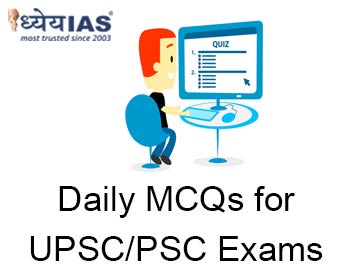Home > Daily-mcqs
Daily-mcqs 17 Oct 2025

Q1:
Consider the following statements regarding Green Crackers: 1. Green crackers emit less particulate matter and gaseous emissions compared to traditional crackers. 2. They have been developed by CSIR to reduce environmental and health hazards. 3. The use of barium nitrate is completely eliminated in all types of green crackers. Which of the statements given above is/are correct?
A: 1 and 2 only
B: 2 only
C: 1, 2 and 3 only
D: None
Answer: A
Explanation:
Statement 1 is correct: Green crackers emit 30% less particulate matter and gases like SO₂ and NOx.
Statement 2 is correct: They were developed by CSIR labs (notably CSIR-NEERI) to reduce the environmental and health impact of traditional crackers.
Statement 3 is incorrect: Barium nitrate is not completely eliminated in all types; some variants significantly reduce or replace it, but not all eliminate it entirely.
Q2:
Consider the following statements about Personality Rights under Indian law: 1. India has a dedicated statute explicitly defining and regulating Personality Rights. 2. Personality Rights are protected under Article 21 of the Indian Constitution. 3. The Trademark Act, 1999 provides some protection for personality rights. 4. Personality Rights always survive after the person’s death . Which of the above statements is/are correct?
A: 1 and 2 only
B: 1,3 and 4 only
C: 2 and 3 only
D: 1, 2, 3 and 4
Answer: C
Explanation:
Statement 1 is incorrect. There is no dedicated law/statute in India that explicitly defines or fully regulates “Personality Rights.” These rights are recognised through judicial precedents and by relying on constitutional rights and existing laws.
Statement 2 is correct. Personality Rights are protected under Article 21 (Right to Life and Personal Liberty) as interpreted to include right to privacy and dignity.
Statement 3 is correct. The Trademark Act, 1999 provides some protection, e.g. if someone tries to register or use a name, image etc., in a way that misleadingly suggests association with a person without their consent.
Statement 4 is incorrect. Personality rights do not always survive after death in Indian law. There is no settled law that guarantees perpetual right of publicity/personality for deceased persons.
Q3:
Consider the following statements in the context of Article 20(3) of the Indian Constitution and the recent SC ruling in Rahul Agarwal v. State of West Bengal & Anr (2025): 1. The Supreme Court held that voice samples are “testimonial evidence” and thus protected under Article 20(3). 2. According to the SC, a Judicial Magistrate has no power to direct accused to provide voice samples. 3. Article 20(3) prohibits the compulsion to give physical evidence (like fingerprints, DNA, voice samples). Which of the statements given above are correct?
A: 1 only
B: 2 only
C: 2 and 3 only
D: None
Answer: D
Explanation:
Statement 1 is incorrect. The Supreme Court held that voice samples are not “testimonial evidence” and thus not protected under Article 20(3).
Statement 2 is incorrect. The Court explicitly held that Magistrates may order voice samples both from the accused and witnesses.
Statement 3 is incorrect. Article 20(3) does not prohibit the compulsion to give physical evidence like fingerprints, handwriting, voice, or DNA. The distinction is that these are non‐testimonial/material evidences, which are outside the scope of what Article 20(3) protects. The protection is only for testimonial compulsion (i.e. forcing someone to give statements from their mind).
Q4:
Consider the following statements regarding the recent Supreme Court decision on direct recruitment of District Judges under Article 233 of the Constitution: 1. A judicial officer who previously practised as an advocate can be eligible under the direct recruitment quota, provided the combined experience (as advocate + as judge) is at least 7 years. 2. The Court held that eligibility under Article 233 must be determined at the time of appointment, not at the time of application. 3. The Court fixed a minimum age of 35 years for all direct recruitment candidates (whether from Bar or service). Which of the statements given above are correct?
A: 1 and 2 only
B: 1 and 3 only
C: 2 and 3 only
D: 1, 2, and 3
Answer: B
Explanation:
Statement 1 is correct. The Supreme Court held that judicial officers who had practiced as advocates before entering service can compete under the direct recruitment quota, if their combined experience (advocacy + judicial service) is at least 7 years.
Statement 2 is incorrect. The Court held that eligibility should be assessed at the time of application, not appointment.
Statement 3 is correct. The Court directed a minimum age of 35 years as on the date of application for all candidates (Bar or judicial officers).
Q5:
Consider the following statements about recent defence transformation initiatives in India: 1. The year 2025 has been officially declared by the Ministry of Defence as the "Year of Reforms", with priorities including integrated theatre commands. 2. India’s policy of Positive Indigenisation Lists means that some defence equipment must now be manufactured within India. 3. Under recent reforms, 30% of defence capital procurement budget in 2024-25 has been reserved for Indian companies to encourage technology transfer. Which of the statements given above are correct?
A: 1 and 2 only
B: 2 only
C: 1, 2 and 3 only
D: None
Answer: A
Explanation:
Statement 1 is correct. The MoD has declared 2025 as the “Year of Reforms”, focusing among other things on theatre commands, simpler and quicker procurement, jointness, integration, etc.
Statement 2 is correct. There are Positive Indigenisation Lists covering thousands of items; these mandate indigenisation of many components and systems. Over 5,500 items are on these lists, a large number of which have been or are being indigenised.
Statement 3 is incorrect. In the 2024–25 budgets, 75% of the capital acquisition budget was earmarked for domestic procurement.